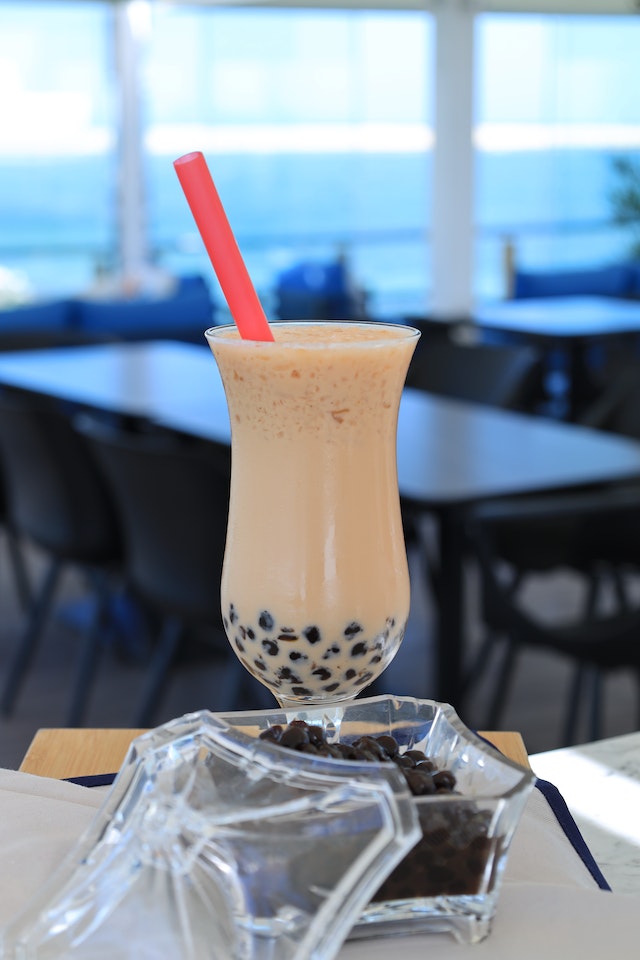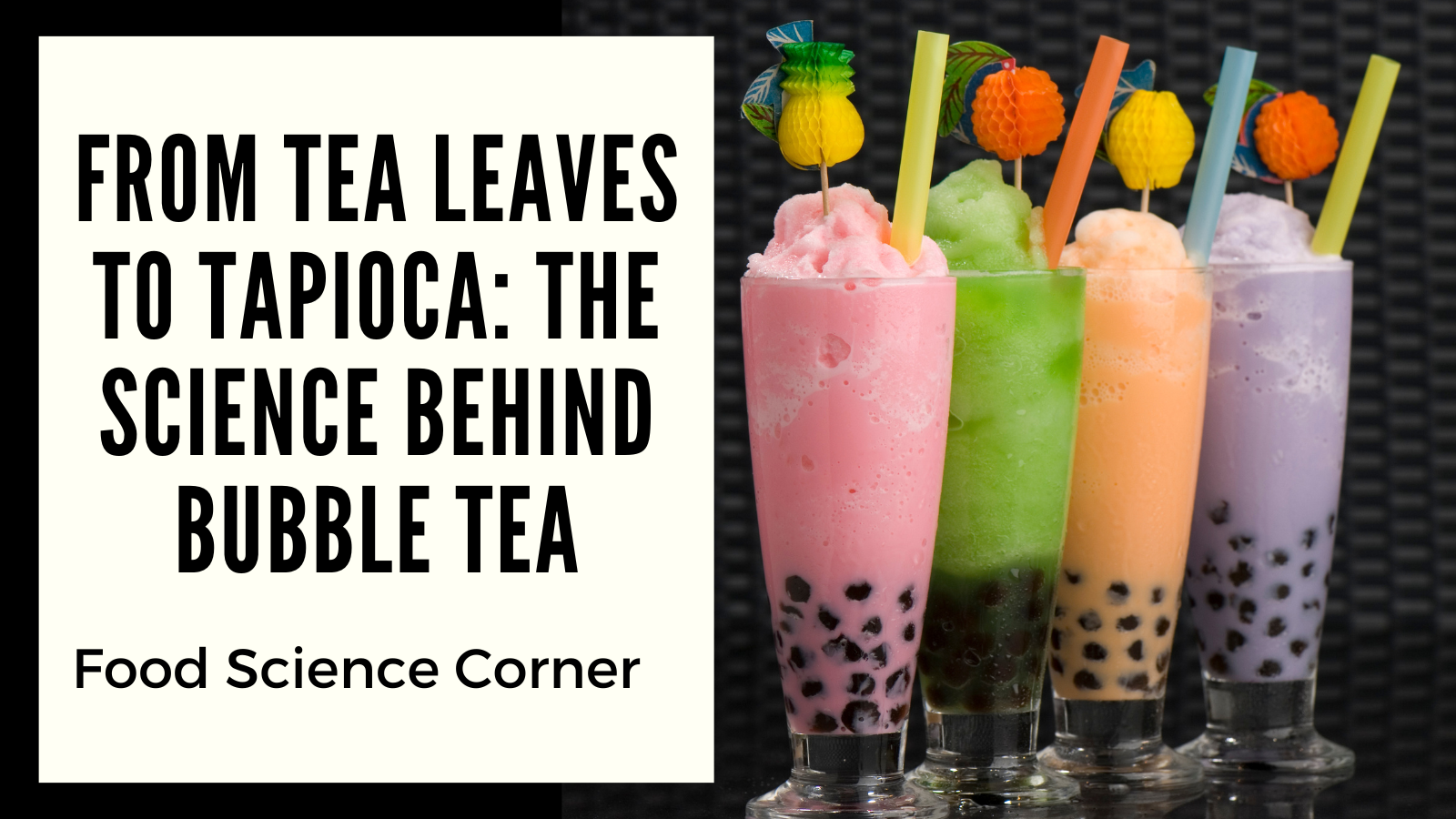From Tea Leaves to Tapioca: The Science Behind Bubble Tea
Last Updated on April 30, 2023
Bubble tea, a tasty, colourful, exciting beverage which is popping with science.
I don’t know how popular bubble tea is where you are, but I can say that it is pretty popular here in Toronto and the GTA. In the past few years, the number of stores opening has been insane.
Bubble tea was created in Taiwan during the 1980s. Its popularity grew throughout Asia and has continued here in North America. [1] There are two popular claims of where specifically bubble tea was created; however, I won’t get into that. If you are interested in learning more, check out the South China Morning Post on how bubble tea went global.
Walking into these stores (at least for me) leads to decision overload. There are so many possible combinations.
What type of tea would you like? How much sugar? What type of topping?
The possibilities are endless, but this also means you can craft your own specialty beverage. (My personal favorite is a Matcha smoothie, 50% sweetness with brown sugar tapioca balls). To celebrate this drink and my love for it, I have decided to write an article sharing the science behind this drink.
So let’s get into it!
What is bubble tea?

There is no “standard” definition of what bubble tea is, as there are many possible combinations that exist. Even at the most basic levels, you can get drinks from bubble tea shops that don’t even have tea in them! Bubble tea can also be called boba, pearl milk tea, boba nai cha or tapioca tea.
However, the most common combination of bubble tea is tea that is paired with chewy tapioca balls. Bubble tea is made up of a plethora of combinations; however, the standard combination for bubble tea is:
- Tea
- Sweetener
- Ice
- An addition of a topping (jellies, pearls etc.)
- Milk/Non-dairy milk
Ingredients in Bubble Tea: Tea
As you could imagine, there is a lot of science that goes into the perfect cup of tea. Bubble tea is known for its unique colors, which contrast against the additional toppings. Because bubble tea’s colors are so iconic, let’s focus on what causes the color in popular varieties of tea.
Bubble tea most frequently incorporates black tea as its base. When brewed, black tea takes on a dark brown color with a tinge of orange and red. Black tea is made by fermenting tea leaves, allowing for the development of black tea pigments, including theaflavins (TFs, golden yellow), thearubigins (TRs, orange brown), which are largely responsible for brightness, briskness, color, and strength. [2]
Oolong tea sits between black and green tea on the spectrum of tea oxidation levels. Oolong is a fermented tea made from fermenting black tea leaves until they create a rich delivery of flavor compounds. I was unable to find the exact compounds responsible for Oolong’s color; however, it’s likely that like black tea, its color is due to theaflavins and the fermentation process the leaves undergo.
Green tea is produced by the fixation and the rolling of green tea leaves. The process enables the preservation of the tea leaves and keeps their rich green color. This rich green color comes from chlorophyll, a naturally occurring pigment that enables a plant to convert light into glucose. When green teas are steeped, they can range from deep green, such as in the case of matcha, to a yellowish color in the case of jasmine. [3] The more characteristic yellow colour is due to the presence of water-soluble flavonols (kaemperferol, quercetine,myrecitin) and flavones (apigenin, isovitexin, saponarin),which represent 1.3 to 1.5% and 0.02% of the tea leaves (drybasis), respectively. [4]
Ingredients in Bubble Tea: Milk
The most popular variety of bubble tea is milk tea which combines black tea with milk.
Many people utilize the term creaminess interchangeably to describe flavour and texture even though they are two different things. Milk is largely composed of fats, proteins and sugars which enhances bubble teas “mouthfeel.” When you drink tea alone it is primarily water which makes it feel like you are drinking well water.
However, it’s just as common for milk not to be added at all to bubble tea. Instead, non-dairy creamers are used because some people avoid dairy. The purpose of milk and milk-alternatives is to provide a creamier texture compared to tea only. For the purpose of this section, I am going to refer to all milk and milk-alternatives as milk because I am focusing on texture alone.
Water is an ideal liquid so it flows and has a viscosity of approximately 1.0 cp or 10-3. The viscosity of milk depends on the temperature but representative values at 20°C for skim milk is 1.5cp. [5] It’s not a large difference but there is indeed a difference.
Milk has a higher viscosity than water because it contains caseinate micelles and fat globules. These reduce the flow of the liquid because they are solid particles. Solid particles reduce the flow of something because there are internal forces at work such as hydrodynamic, Brownian and colloidal forces. There is much more at play but what you need to know is that it causes your bubble tea to become thicker when milk is added!
Ingredients in Bubble Tea: Ice
Ice is liquid water that has been frozen.
However, the shape and size of the ice in your bubble tea will affect its flavor, just like with cocktails. The size and density of the ice determine the dilution factor, and when you order bubble tea, you’ll be asked how much ice you’d like (100%, 75%, 50%, 25%, or none). The amount of ice you receive will affect the drink’s flavor, as colder drinks are less sweet and taste different as they melt.
Bubble tea typically has cubed ice, and larger chunks mean a lower dilution factor because there’s less surface area to melt. A cube’s surface area is almost double that of a sphere, so it melts slower than pebble ice.
If you want a highly concentrated tea throughout your drinking experience, order no ice. Just keep in mind that the shop might not fill it up to the top, and less ice means your drink will heat up faster.
Ingredients in Bubble Tea: Sweetener
Syrups are added to bubble tea to enhance its flavor and sweetness. Just like tea flavours there are many options for sweeteners such as fruit syrups, floral syrups and sugar based syrups. Bubble tea most classically known for adding melted brown sugar to it.
Brown sugar is crystalline sucrose with added molasses. Molasses is a thick syrup that is a byproduct of the sugar-making process. It is derived from crushed sugar cane or sugar beets, which are boiled down to extract juice from sugar crystals. The remaining juice is used to create molasses.
Ingredients in Bubble Tea: Boba
The thing that you have all been waiting for. The iconic pearls that give bubble tea it’s signature design.
Boba
What are bubble tea bubbles made of?
The standard “bubbles” of bubble tea are made from tapioca starch. These tapioca balls are chewy, typically black spheres produced from tapioca, which is a starch extracted from the cassava root. Tapioca, when uncooked, is uncolored and doesn’t have much flavor. It isn’t until you cook them and add sugar (like the brown sugar above) that the flavor is improved.
So how does tapioca starch powder become squishy balls that are fun to chew?
Science of course!
Tapioca flour is activated by the addition of heat and water, heating the tapioca starch and causing it to gel.
Starch molecules are essentially large polymer molecules made of glucose units. Heat and water trigger the gelation of tapioca flour, causing the starch particles to swell and break apart. These new pieces are able to create new connections and form a network that can hold water. As the solution cools, it becomes stiffer.
Scientifically, when you heat the tapioca balls, water is able to enter the randomly entangled amorphous regions of the starch molecules. As more water is added, it begins to flow into the polymer, causing the crystalline region to detangle. This allows the long-chain polymers from the crystalline regions to form hydrogen bonds with each other, initiating gelation. This gelation process is what gives tapioca balls their characteristic chewy texture.
Conclusions
In conclusion, bubble tea has become a worldwide phenomenon and its popularity only continues to grow. While its origins may be rooted in tradition and culture, the science behind its creation and the constant innovation in its flavors and ingredients keep it fresh and exciting. So next time you take a sip of your favorite bubble tea, remember that there’s a lot more to this beverage than just its delicious taste – there’s also a fascinating intersection of culture and science that makes it so unique and beloved by many.
References
[1] https://www.scmp.com/magazines/style/leisure/article/3044028/how-bubble-tea-or-boba-went-global-and-who-first-thought
[2] Mao, Ya-Lin, Jie-Qiong Wang, Gen-Sheng Chen, Daniel Granato, Liang Zhang, Yan-Qing Fu, Ying Gao, Jun-Feng Yin, Long-Xin Luo, and Yong-Quan Xu. “Effect of Chemical Composition of Black Tea Infusion on the Color of Milky Tea.” Food Research International 139 (2021): 109945–45. https://doi.org/10.1016/j.foodres.2020.109945
[3] Wang, H., Cao, X., Yuan, Z., & Guo, G. (2021). Untargeted metabolomics coupled with chemometrics approach for Xinyang Maojian green tea with cultivar, elevation and processing variations. Food Chemistry, 352, 129359–129359. https://doi.org/10.1016/j.foodchem.2021.129359
[4] Chaturvedula, V. S. P., & Prakash, I. (2011). The aroma, taste, color and bioactive constituents of tea. Journal of Medicinal Plants Research, 5(11), 2110-2124.
[5] Wong, N. P., & Jenness, R. (1999). Fundamentals of Dairy Chemistry. Gaithersburg, MD: Aspen.


Comments are closed